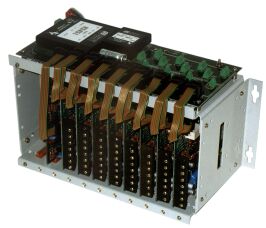Converters
The
certificates of Ministry of the Russian Federation for Communications
and Informatization
#ОС/1-Г-247.
Digital
trunks signaling converters
Signaling
converters provide the interoffice interaction, using the different
interaction protocols while establishing of connections of all
types.
The possibility of remote access for the converters control (the
changes in configuration, functioning control, etc.) is provided
- locally (by the RS-232 interface), by the modem (built-in, external),
or by the Ethernet network (TCP/IP).
Converters' power supply can be carried out from the constant-current
source 48/60 V, or from the alternating current source 220V.
There are two variants of the converters constructive fulfillment.
• for setting in 19'' frame
• in micro-PC case.
Download catalogue
(296 K)
ISM
model
Fulfils
the transformation from SS No.7 signaling protocol into DSS1/QSIG
signaling protocol.
The use of the converter allows to organize the interaction between
the exchanges, using SS No.7 signaling protocol, and the systems
utilizing primary access lines with DSS1 protocol, ETSI version
for the connection with the supporting exchanges (PABX with ISDN
functions, ISDN concentrators and multiplexers).
The possibility of called subscriber's number format transformation
for the DSS1 -> SS No.7 calls is provided.
ISDN additional services are supported: DDI, CLIP, CLIR, COLP,
COLR, USS-type 1.
CSM
model
Fulfils
the transformation DSS1/QSIG protocol into 2CAS signaling.
Converter may be used for the organization of interaction between
the exchanges with 2CAS signaling (decade dialing, "MFC shuttle",
"MFC packet", ANI) and the systems, utilizing primary
access lines with DSS1 protocol, ETSI version for the connection
with the supporting exchanges (PABX with ISDN functions, ISDN
concentrators and multiplexers) or with QSIG protocol. The automatic
incoming connection to the subscribers of small PABX with ISDN
functions from the outside of electromechanical offices is provided.
Converter is also may be used for the connection of access Internet
servers to the exchanges, supporting 2CAS signaling.
The possibility of ANI individual information transmission, ANI
request at incoming connection from the outside of 2CAS signaling,
DDI, CLIP additional services granting, called and calling subscribers'
numbers transforming is provided.
USM
model
Fulfils
the transformation SS No.7 signaling protocol into 2CAS signaling.
The use of the converter allows two exchanges to interact between
each other, in case when one of them supports SS No.7 signaling
protocol (MTP, ISUP) and the other - 2CAS signaling protocol signaling
("MFC shuttle", "MFC packet", ANI).
The possibility of called and calling subscribers' numbers transforming,
ANI individual information transmission, ANI request at incoming
connection from the outside of 2CAS signaling, DDI, CLIP additional
services granting is provided.
RSM
model
Fulfils
the transformation SS No.7 or DSS1 signaling protocol into 1CAS
signaling ("norka", inductive code).
Converter use allows to connect the equipment of rural and departmental
networks with anew established equipment (for example, at the
upgrading of rural communication node or at departmental network
expansion).
The possibility of ANI request, CLIP additional service granting
is provided.
VSM
model
Fulfils
the transformation V5 signaling protocol into DSS1 signaling protocol
(PRI, ETSI version).
Converter use allows connecting the access network equipment (concentrators,
WLL systems) with V5.2 or V5.1 interface to the supported exchange
(PABX) with DSS1-PRI signaling system.
VSM converter use will provide the concentration of subscriber
calling rate. This will allowed to use the subscriber capacity
of communication system more efficiently.
XSM
model
Fulfils
the transformation of early or nonstandard SORM protocol versions
into the version, which corresponds to the requirements of data
transmission channels. Converter adaptation to each specific case
is possible depending on realization method of SORM at the exchange.
Converter has the opportunity to represent the connection state
information as from the LE just as from control console.
There are two converters' modifications: for fixed networks and
for SPRS networks.
KPS
R2xR1.5 model
Fulfils
the transformation R2 DTMF or R2 MFS signaling protocol into R1.5
(the digital trunk with 2CAS line signaling and 2 from 6 register
signaling by "MFC shuttle" method).
Converter provides the exchange interaction at establishing of
the connections: local outgoing trunk, local incoming trunk, long-distance
outgoing to toll exchange by order trunk, long-distance incoming
from toll exchange by toll trunk.
Analog
trunks signaling converters
KPS3x2
model
Provides
the connection of small capacity private-branch office to 3-wire
analog trunk of the urban network with the help of 2-wire subscriber
lines or 2-wire lines with DID protocol, supporting in that way
the possibility of automatic incoming connection from urban network
to private-branch office subscribers.
Converter receives the called subscriber's number information
from 3-wire analog trunk with decade dialing , provides the support
of standard 3-wire trunk signaling protocol, occupies 2-wire private-branch
office line and transfer the number in DTMF code.
Amount of digits, received from the urban network and transferred
to private-branch office, is stipulated in each specific case.
KPS3xE&M(I,V)
model
Provides
the interaction between automatic telephone exchange with 3-wire
analog trunks and private-branch offices with E&M(V) interface,
rural exchanges and private-branch offices with E&M("inductive
code") interface.
E&M interface has 2-wire conversational trunk.
All analog trunk signaling converters are made in micro-PC constructive.
Geography
of the users
Signaling
converters are successfully used nowadays in such cities as St-Petersburg,
Moscow, Bishkek, Vyborg, Izhevsk, ignalina, Kiev, Mtsensk, Ramenskoye,
Naryan-Mar, Nazran, Omsk, Rostov-on-Don, Smolensk, Dushabe, Vladivostok
and others.
Phone: +7
(812) 369 29 78
Fax: +7 (812) 369 29 72
Email: nio1@niits.ru |

